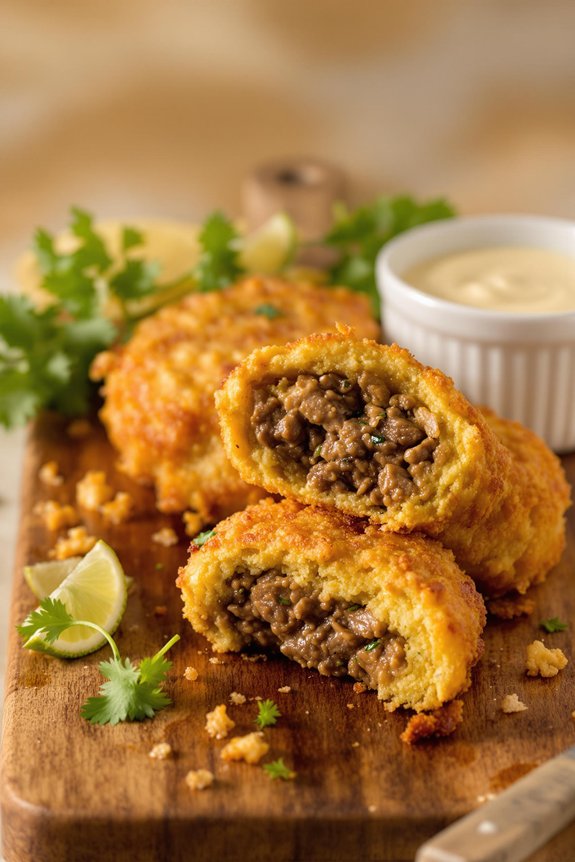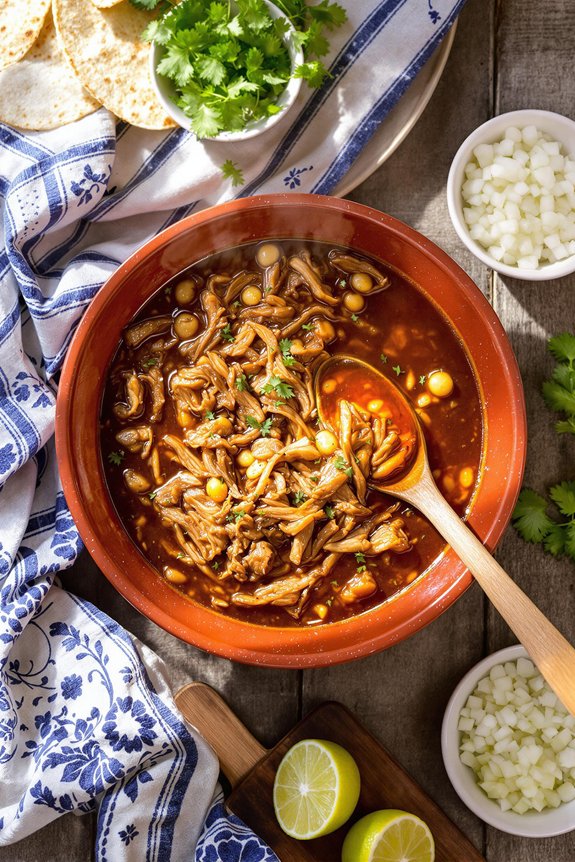Why You’ll Love these Crispy Puerto Rican Alcapurrias
Nostalgia in every bite! These alcapurrias transport me to the bustling streets of Puerto Rico, where the aroma of sizzling fritters fills the air.
I’m obsessed with the crispy exterior that gives way to a soft, flavorful masa made from green bananas, plantains, and yautía. The savory meat filling hidden inside? Pure genius.
What makes these irresistible is the contrast – crunchy outside, tender inside, with that punch of sofrito that can’t be replicated.
They’re perfect for gatherings, as a hearty snack, or honestly, whenever a craving strikes. The traditional preparation method yields authenticity you simply can’t rush.
What Ingredients are in Crispy Puerto Rican Alcapurrias?
Traditional Puerto Rican alcapurrias rely on a unique combination of starchy vegetables for the masa (dough) exterior and a flavorful meat filling inside. The masa ingredients create that distinctive crispy-yet-tender texture that makes alcapurrias so beloved across the island. Each component plays a vital role, from the green bananas that form the base to the achiote oil that adds both color and flavor.
Ingredients:
- 2 pounds green bananas (not yellow, must be unripe)
- 3 green plantains (unripe)
- 1 pound yautía (also known as malanga)
- 1 large white potato
- 15 ounces evaporated milk
- 3 tablespoons achiote (annatto seeds)
- 1/8 cup vegetable oil (for creating achiote oil)
- 3 tablespoons sofrito sauce
- Salt and pepper to taste
- Oil for frying
- Meat filling (beef, veal, and pork combination as used in pastelillos)
A few notes about these ingredients: quality matters tremendously here. Look for firm green bananas and plantains with no signs of yellowing, as ripeness will affect the texture of your masa. The achiote seeds create that signature reddish color that makes alcapurrias instantly recognizable. While the recipe mentions you can omit veal and pork from the filling, the traditional combination creates the most authentic flavor profile. And remember, no food processors here—the authentic texture comes from hand-grating all those starchy vegetables, which creates the perfect consistency that machines simply can’t replicate.
How to Make these Crispy Puerto Rican Alcapurrias

Making authentic alcapurrias begins with careful preparation of the masa. Start by preparing your starchy vegetables. Cut the ends off 2 pounds of green bananas and make a lengthwise slit in the skin, being careful not to cut too deep. Soak them in hot, salted water to make peeling easier. Once the skin starts separating, use a rocking motion with your knife to remove it completely.
Follow the same process with the 3 green plantains. Peel your 1 pound of yautía and large white potato, placing each in separate containers of cold salted water as you go.
Now comes the part that truly distinguishes homemade alcapurrias—hand grating. This is where patience pays off, trust me. Using a regular grater (no food processors allowed for authentic texture!), grate the bananas, plantains, and yautía into a large roasting pan, saving the potato for last since it helps clean the grater.
Once everything’s grated, mix in 3 tablespoons of sofrito, half the can (about 7.5 ounces) of evaporated milk, salt and pepper to taste, and finally, strain in your achiote oil—made by heating 1/8 cup vegetable oil with 3 tablespoons achiote until it turns red.
Mix thoroughly with clean hands, working the masa like bread dough until the color is uniform. Let this mixture rest in the refrigerator for at least four hours or overnight—this waiting period is non-negotiable for perfect texture.
When you’re ready to cook, heat oil in a deep fryer or caldero to about 360°F. Take a kitchen spoonful of masa and place it in your palm, add a teaspoon of the meat filling in the center, then fold and roll it into a cylinder shape, making sure the filling is completely enclosed.
Fry the alcapurrias in small batches, spooning hot oil over the tops until they’re golden brown all over. Patience is key here—fry them slowly so they cook completely inside while developing that irresistibly crispy exterior.
Once done, drain on paper towels before serving. For an authentic Spanish twist, consider adding a pinch of premium saffron to your masa mixture for subtle color and distinctive flavor. The contrast between the crisp outer shell and the savory filling inside makes these fritters absolutely worth the effort.
Crispy Puerto Rican Alcapurrias Substitutions and Variations
While traditional recipes have their place, I’ve found that alcapurrias can be wonderfully adaptable to what you have on hand.
Can’t find yautia? Simple white potatoes work in a pinch, just adjust the liquid slightly as they’re less starchy. For the filling, try ground turkey instead of the beef-pork-veal mix for a lighter option, or go vegetarian with seasoned lentils and mushrooms.
The achiote oil gives that distinctive color and flavor, but paprika mixed with a bit of turmeric can create a similar effect.
And if grating by hand sounds like torture, a food processor with the grating attachment is your modern-day savior.
What to Serve with Crispy Puerto Rican Alcapurrias
Three perfect companions elevate your crispy alcapurrias from snack to satisfying meal.
I love pairing these golden fritters with a zesty mayo-ketchup sauce (just mix equal parts and add a dash of garlic).
For a complete street food experience, serve alongside tostones—twice-fried plantain slices with a sprinkle of salt.
Can’t get more authentic than that.
A light side salad with avocado and cilantro balances the richness.
The cool, crisp textures contrast beautifully with the warm, savory alcapurrias.
Trust me, your taste buds will thank you for this Caribbean-inspired combination.
Final Thoughts
These crispy alcapurrias have become my favorite Puerto Rican street food for good reason.
The contrast between that perfectly crunchy exterior and the savory meat filling is simply irresistible.
Making them at home might seem intimidating with all that grating by hand, but trust me, the authentic texture you get is worth every bit of effort.
I can’t imagine achieving the same results with a food processor.





